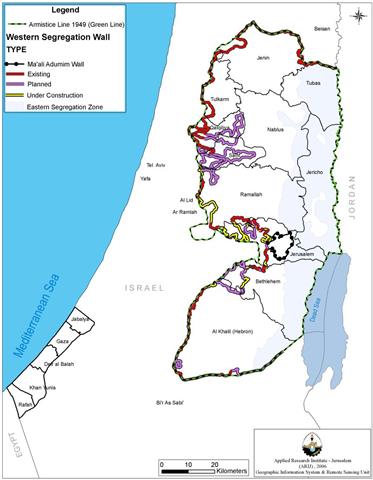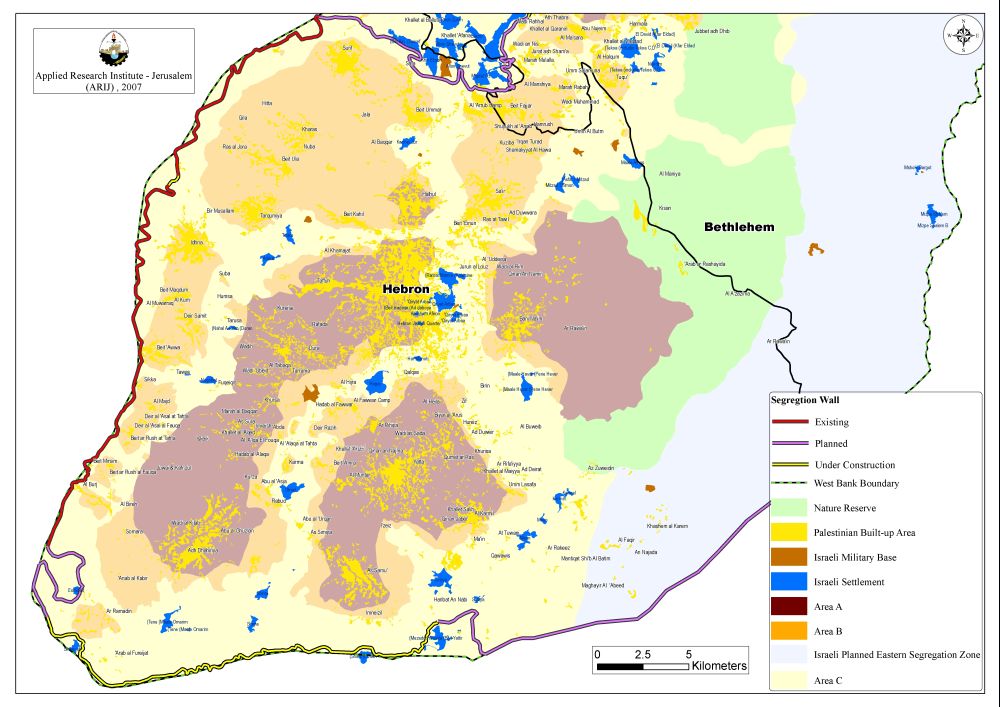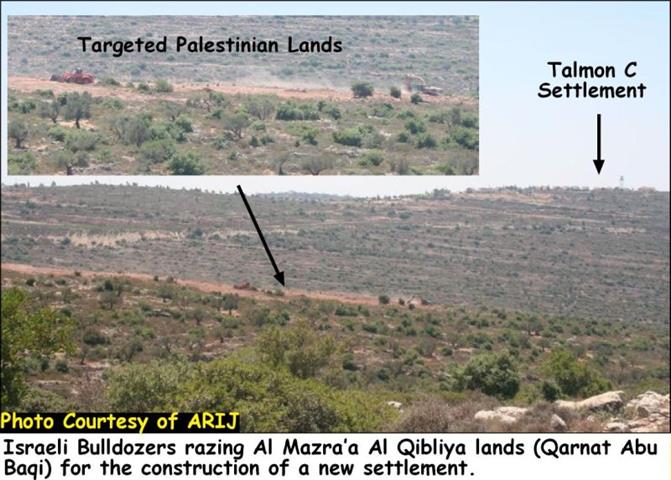THE SEGREGATION WALL IN THE WEST BANK
The Israeli Segregation Wall is an Israeli project started as a security pretext to establish a barrier to stop Palestinian resistance from infiltrating into Israel. However, evidence on the ground revealed that Israel is aiming for more than it claims. The route of the Segregation Wall showed that Israel aims to make of it more than a barrier; it is much more like border for the State of Israel. In the process, Israel made sure to include vast areas of land toward the Israeli side with as many settlements as possible and with less Palestinians as possible. For Israeli it is a demographic and geographic challenge. Israel destroyed the Palestinian lands and property, separated and isolated villages from their agricultural lands and from each other, natural resources (specially water resources), is also a an aim of the Israeli Army that made sure to include on the wrong side of the Wall. The vast empty lands were also a target for the Israeli Army, on which more settlements will be built and existing settlements will expand. Simply, the Segregation Wall is the new face of the Illegal permanence of the Israeli Occupation to the Palestinian Territory.
The Israeli Segregation Wall in the occupied Palestinian Territory cuts across the western part of the West Bank and runs from north to south grabbing the most fertile agriculture lands, isolating the Palestinian communities into enclaves, undermining the territorial contiguity between the Palestinian cites and villages controlling the natural wealth and resources and embrace most of the enormous Illegal Israeli settlements.
The final version of the Israeli Segregation Wall was released in April 2006, where the Wall run for 725 Km along the western Segregation Wall in the West Bank, out of which, only 128 Km (18.2 % of the total length) will run on the 1949 Armistice Line (the Green Line). When completed, the Segregation Wall will isolate behind it some 576 Km2 of Palestinian land (10+% of the total West Bank area). It will to enclose 103 Israeli settlements, with a population close to 425,000 (85%) of the Israeli settlers’ total population in the West Bank (500,000+); at the same time it isolates more than 60 Palestinian localities with more than 90,000 Palestinians behind the Segregation Wall, next to nearly 200,000 Palestinian in occupied East Jerusalem. See Map 1 & Table 1
Map1: The Western Segregation Wall in the West Bank
| % of Total Wall Length | Table 1, shows the Status of the Western Segregation Zone as of April 2006 (including adjustments) | |
| 62 % | 450Km | Existing Sections |
| 24 % | 173 Km | Planned Sections |
| 14 % | 102 Km | Under Construction |
| 100% | 725 Km | Total Length |
Source: ARIJ GIS Unit 2007
TO BE COMPLETED BY 2010
In July 2007, the Israeli Ministry of Defense revealed that the building of the Segregation Wall in the occupied Palestinian territory will continue through the years 2008 and 2009 and will not be completed until the years 2010. the source claims that the delay is due to Palestinian petitions submitted to the Israeli Supreme Court “of Justice” to review the route of the Wall; next to an environmental considerations and disputes in several locations, the southern hills of Hebron, the route of the Segregation Wall around Jerusalem, specially the part section of the Wall to wrap Ma’ale Adumim settlements bloc. The same goes for the part section of the Wall that wrap around Gush Etzion settlements bloc south of Jerusalem and southwest of Bethlehem Governorate; where the Wall will isolate 9 Palestinian communities off from the main urban center in Bethlehem Governorate.
IN HEBRON GOVERNORATE
The Israeli Segregation Wall in Hebron Governorate extends a total length of 125.5 km (17.3% of the total length of the Segregation Wall in the West Bank). the Wall, once completed will isolate behind it nearly 54,000 dunums (5% of the total area of Hebron Governorate). The existing Segregation Wall section in Hebron Governorate starts at the southern end of Gush Etzion settlements bloc and ends in Al Hathalin Bedouin area in the eastern slopes of the Governorate. See map 2.
Map 2. The Segregation Wall in Hebron Governorate
THE SEGREGATION WALL IN JERUSALEM GOVERNORATE
The Israeli Segregation Wall in Jerusalem is part of the Israeli plan to cut off the holy city from the rest of the West Bank. The Wall starts from the Palestinian village of Beit ‘Anan where the it annex the Illegal Israeli settlement of Har Adar, and then it continues to the north to encompass Giv’at Ze’ev Settlements Bloc. After that, the Wall runs eastward to encompasses Ma’ale Adumim Settlements Bloc, where it stretch toward the south cutting through several Palestinian communities until it reaches the northern part of Bethlehem Governorate, where the Wall goes southward to encompasses Gush Etzion Settlements Bloc. For Israel the entire wrap of the Segregation Wall around Jerusalem will allow them to unilaterally redraw for a second time the boundariy of Jerusalem to what they claim “Greater Jerusalem” plan. See Map 3
Map 3. The Segregation Wall in Jerusalem Governorate
LEGAL & INTERNATIONAL STATUS
All the construction carried out by Israel in the occupied Palestinian territory, starting with the construction of Israeli settlements, bypass roads, military bases and the Segregation Wall is absolutely Illegal according to the International Law rules and conventions, and clearly contradicts with the International legitimacy and consensus which call for the Israel to withdraw from all the Palestinian lands it occupied in 1967. The International Court of Justice (ICJ) called in its landmark ruling of july 9, 2004 upon Israel to dismantle the segregation wall andfor reparation of all damges occurred to Palestinian land. It went even further to consider all Israeli activities, building settlements, bypass roads, houses demolishing, uprooting trees, etc are all illegal and in vilation of international law. The ICJ called upon Israel to seize all of its activities and take steps on the ground to create positive circumstances where a viable independent Palestinian state maybe conceivable.
The July 9, 2004, ICJ Advisory Opinion on the Legal Consequences of the Construction of the Segregation Wall in the Occupied Palestinian Territory.
'The Court has reached the conclusion that the construction of the wall by Israel, the occupying power, in the Occupied Palestinian Territory including in and around East Jerusalem and its associated régime, is contrary to international law and has stated the legal consequences that are to be drawn from that illegality'.
Also 'Israel is under an obligation to make reparation for all damage caused by the construction of the wall in the Occupied Palestinian Territory, including in and around East Jerusalem'.
'All States are under an obligation not to recognize the illegal situation resulting from the construction of the wall and not to render aid or assistance in maintaining the situation created by such construction; all States parties to the Fourth Geneva Convention relative to the Protection of Civilian Persons in Time of War of 12 August 1949 have in addition the obligation, while respecting the United Nations Charter and international law, to ensure compliance by Israel with international humanitarian law as embodied in that Convention.'
In addition, the construction of the Israeli Apartheid Segregation Wall clearly violates
-
Hague Convention IV (18 October 1907): Convention Respecting the Laws and Customs of War on Land: Article (23):'To destroy or seize the enemy's property, unless such destruction or seizure be imperatively demanded by the necessities of war”.
-
Convention (IV) relative to the Protection of Civilian Persons in Time of War. Geneva, 12 August 1949, Article 53: “Any destruction by the Occupying Power of real or personal property belonging individually or collectively to private persons, or to the State, or to other public authorities, or to social or cooperative organizations, is prohibited, except where such destruction is rendered necessary by military operations.'
-
Article 147 of the same convention indicated that: “Extensive destruction and appropriation of property not justified by military necessity and carried out unlawfully and wantonly, is a grave breach of the Convention.”
-
Art. 23 of the Hague Convention of 1907 also provide: In addition to the prohibitions provided by special Conventions, “it is especially forbidden to destroy or seize the enemy's property, unless such destruction or seizure be imperatively demanded by the necessities of war.”
Prepared by:
The Applied Research Institute – Jerusalem
















